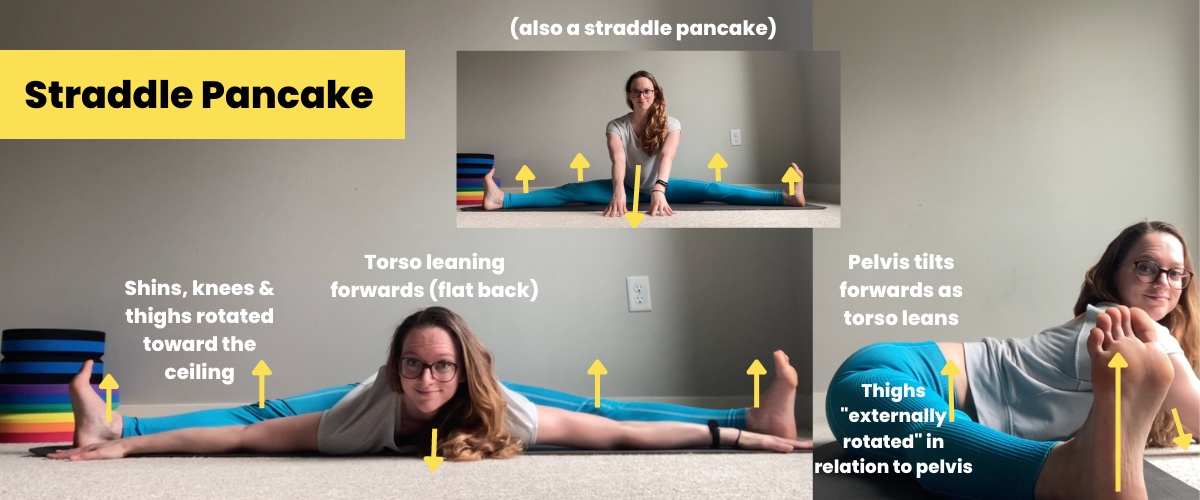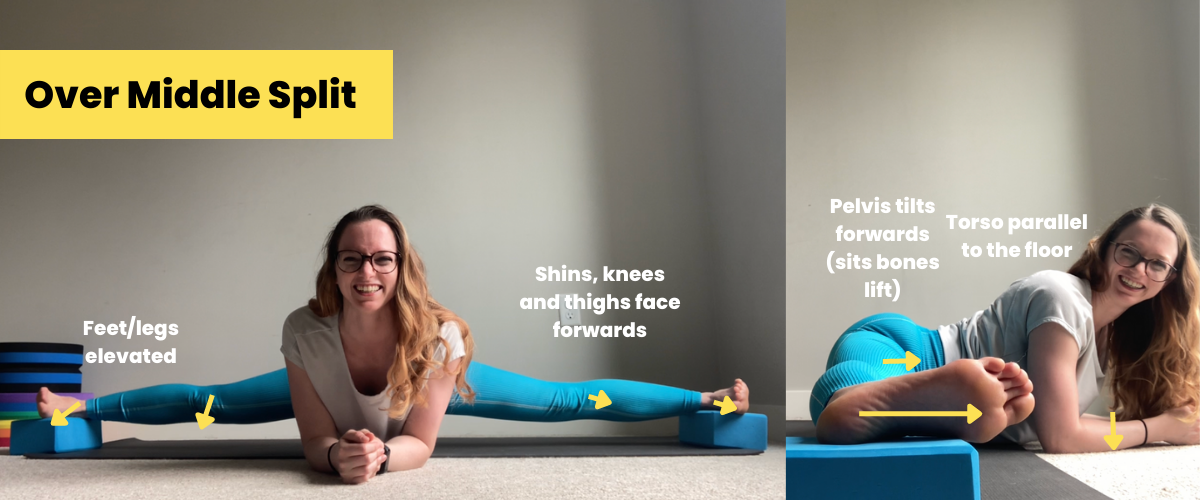Straddle vs. Middle Split - What’s the Difference?
Straddle vs. Middle Split - What’s the Difference?
No, the kitty isn’t the only difference!
Having dabbled in the wide world of contortion training for 11+ years now, I’ve come to learn that there are some serious inconsistencies in naming conventions for stretches/poses. But when it comes to straddles and middle splits, all instructors can agree that these are distinctly different poses.
Why does that matter to you? It influences what muscles you need to train to be able to do them, and informs the “proper” form for safely working on your hip flexibility for these shapes.
Read on for a run-down of the major differences between the commonly mixed-up straddle, straddle pancake, and middle split - as well as some other variations of straddles and middle splits.
Straddle
In a straddle, you should be sitting with your butt on the floor (or a block), with your pelvis in a neutral position and knees pointing up towards the ceiling. It doesn’t matter whether your legs make a narrow pizza slice, or whether you’ve got your legs open a whole 180 degrees out to the sides - if your sits bones are on the floor and knees are facing the ceiling, then it’s a straddle!
Muscles Stretched:
Adductors (inner thighs)
Potentially hamstrings (if you have tight hamstrings) - you only need enough hamstring flexibility to sit up straight with a flat back
One of the biggest challenges to opening our legs wider in a straddle (which is often the goal) is we not only need super flexible inner thighs, but we also need strong glute muscles to physically pull our legs out wider. Contrast this with a middle split (see below) where we also need a lot of inner thigh flexibility, but we have gravity “helping” pull our legs wider, so it’s not as much of a challenge on our glutes.
Related Blog Post: 10-Minute Middle Split & Straddle Routine
Straddle Pancake
This is where you start in a straddle, then add a forward fold, as if you were going to flatten, or “pancake” yourself to the floor. Make sure to keep a flat back when reaching forward! It’s common for students with tight inner thighs (and/or weak glutes) to have their knees rotate forwards slightly, but this cheats the stretch (and can potentially lead to some pinching discomfort in your hip if your thigh bone hits your hip bone).. Keeping the knees and thighs pointing up towards the ceiling ensures a safer, and more sustainable position for your hip-femur alignment - this requires “external hip rotation” of your thigh bones in relation to your hip bones.
Muscles Stretched:
Hamstrings
Adductors (inner thighs)
Lower back muscles
Glutes (in relation to an upright straddle - you may or may not actually feel this as a glute stretch)
Related Blog Post: 6 Active Flexibility Drills for Your Straddle Pancake
Middle Split
Like our straddle, a middle split requires a whole lot of inner thigh flexibility (especially if your goal is a flat middle split). But the main difference here is that our pelvis and thighs are tilted forwards, lifting our butt off the ground, allowing gravity to help pull our hips lower (and/or widen our legs farther out to the side).
You can basically think of your middle split as a straddle, but with the whole shape rotated 90 degrees forwards!
Muscles Stretched:
Adductors (inner thighs)
Potentially hamstrings (if you have tight hamstrings)
Note: just because gravity is “helping” us in this position to get an inner thigh stretch doesn’t mean that we still don’t need to strengthen our glutes in this position! Being able to engage your glutes in a middle split not only physically helps us open our legs wider, but it communicates to our nervous system that we’re “strong” and “stable” in this position, which then lets our nervous system relax our inner thighs to stretch a little bit more.
Over Middle Split
“Over” generally refers to going past the normal range of motion required for flat splits. An “over” middle split refers to a middle split where your feet or legs are elevated allowing your hips to open even past 180 degrees. Notice that aside from the feet being elevated, the rest of the posture in this pose is identical to our “regular” middle split (knees and thighs are pointing forwards, the pelvis is tilted forwards, and the torso is parallel to the ground).
Muscles Stretched:
Adductors (inner thighs)
Over Straddle Pancake
Similar to our “over” middle split, we can do an “over” straddle by putting our feet or legs on top of yoga blocks. And when we lean forwards in our straddle, this becomes our over straddle pancake, an even deeper straddle stretch for folks who can already lean very far forwards in their traditional straddle pancake.
Muscles Stretched:
Hamstrings
Adductors (inner thighs)
Lower back muscles
Glutes (in relation to an upright straddle - you may or may not actually feel this as a glute stretch)
Active Straddle Hover
Now here’s a fun active flexibility challenge for folks who like working on their straddles - the straddle hover. In the straddle hover, we’re taking our regular ol’ straddle, and using our hamstring strength to hold our hips in the air. I wrote a whole blog post about working on this move if this is something you’re interested in training the strength for (the secret is starting with the blocks closer to your hips!).
Muscles Stretched:
Adductors (inner thighs)
Hamstrings (depending on how much you lean forwards - and this is an active stretch, meaning your hamstrings are contracting while they’re lengthening!)
Related Blog Post: How To: Active Straddle Hover
Straddle Pike
A '“straddle pike” is most often used to refer to a straddle where you are upside down and your hips are in a piked position, but technically it can refer to any straddle position with piked hips. “Piked” hips refers to the fact that our hips are flexed, and there’s a 90 degree angle between our thighs and our torso. When you’re upside down, that means your thighs and knees are facing the floor.
Muscles Stretched:
Adductors (inner thighs)
Potentially hamstrings (if you have tight hamstrings)
Open Straddle
In contrast with our straddle pike, in an open straddle, the front of our hips are flat, with our thighs and knees facing forwards. This is most often used to describe our legs/hips in upside down shapes like handstands or headstands. At some point, the bony structure of your hips will limit how wide you can open your legs in your open straddle, which is why it’s more common to train our flexibility in piked hip positions where we can influence the soft tissue like muscles to increase our flexibility.
Muscles Stretched:
Adductors (inner thighs)
Potentially hip flexors (if you have tight hip flexors)










